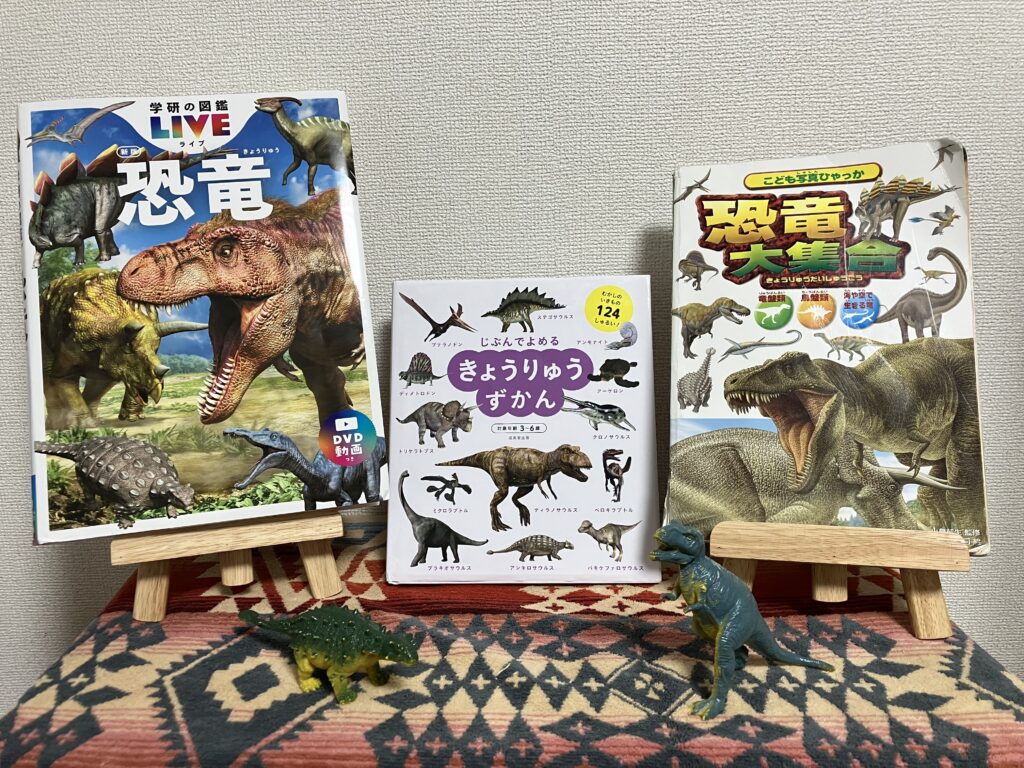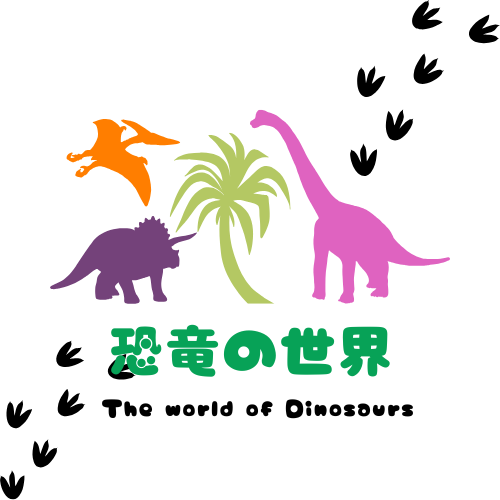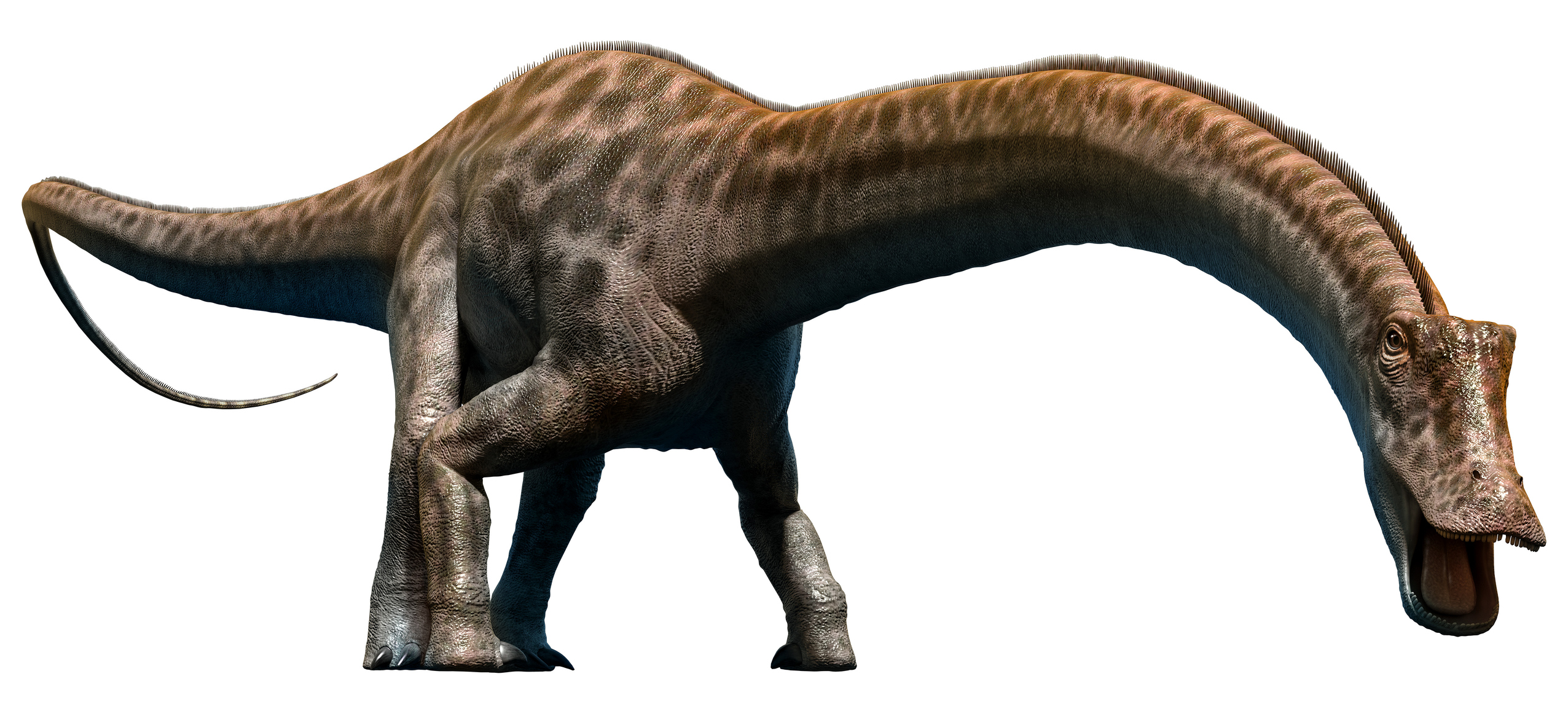📝基本情報(Basic Information)
・生物分類:ディプロドクス科 (Biological classificatio:Diplodocidae)
・体長:約24〜27メートル 最大30メートルに達する個体もいた (Body length:It measured approximately 24 to 27 meters in length, with some individuals possibly reaching up to 30 meters.”)
・体重:約10〜16トン (Weight:Approximately 10 to 16 tons )
・高さ:首を上げたときの最大高さ 約6〜7メートル (Height: Maximum height when the neck was raised: approximately 6 to 7 meters.)
・生息地:北アメリカ (Habitat:North America )
・時代:ジュラ紀後期 約1億5,400万年前 (Epoch:Late Jurassic period, approximately 154 million years ago.:)
・食性:植物食 (Diet:herbivore)

ディプロドクスは前脚が後脚よりも短いので、体全体が前傾姿勢になっています。なので長い首を上に持ち上げるのは苦手だったようです。もっぱら食事は地面近くの植物を食べていたようですね…..何のために首が長く進化したんですかね?😅
(Diplodocus had shorter front legs than hind legs, so its whole body leaned forward. Because of that, it likely wasn’t good at lifting its long neck upward. It seems it mostly fed on low-lying plants… So, I wonder—why did it evolve such a long neck in the first place? 😅)
👀特徴(Feature)
・小さな頭:体のサイズに比べて非常に頭が小さいです。鼻の穴が頭の上の方に位置していたので可能性があるようで、今は否定されていますが、昔は水中生活説が昔はあったようです。 (Small head: Its head was very small compared to its body size. Since its nostrils were located high up on its head, there was once a theory that it lived in water, although that idea has since been dismissed.)
・長い首:長い首だけあって大きい頸椎が15個以上あったようです。先ほど説明したように、上方への可動域はそれほど大きくはなく、横方向の可動域が広くなっています。 (Long neck: As expected from its long neck, it had more than 15 large cervical vertebrae. As mentioned earlier, its range of motion upward was not very large, but it had a wide range of motion from side to side.)
・ムチのような尻尾:非常に長くてムチのように細い尻尾を持っています。なんと体長の半分以上が尻尾で占めています。尻尾をムチのように振り回して敵を威嚇したり、音を出してコミュニケーションをとっていたという説があるようです。 (Whip-like tail: It had an extremely long, whip-like slender tail. Amazingly, the tail made up more than half of its total body length. There are theories that it used the tail like a whip to intimidate predators or to produce sounds for communication.)

竜脚類恐竜には特徴的な気嚢(きのう)構造があったようです。これは現代の鳥類と共通している構造の様です。これは肺の周りに袋があってその袋から常に新鮮な空気(酸素)が肺に流れる仕組みになっているようですね。面白いですよね~、今度は鳥にはまっちゃうかも😁
(Sauropod dinosaurs are thought to have had a distinctive air sac system, which is a feature they share with modern birds. This system involves sacs around the lungs that allow a constant flow of fresh air (oxygen) into the lungs. It’s really fascinating—now I might end up getting hooked on birds next! 😁)
🏃♀️走る速さ:推定走行速度(Running speed :estimated running speed)
ディプロドクスの一般的な推定速度は時速約8〜17kmであったようですね。非常に遅いですが、理由は3つ考えられています。①体が大きすぎる。➁前脚が短く前傾姿勢なため、そもそも走りづらい。➂体が大きので転ぶと危険なため、動きよりも安定を求めた。とのことのようです。 (The estimated walking speed of Diplodocus was around 8 to 17 km/h, which is quite slow. There are three main reasons thought to explain this:①Its body was simply too large.➁Its short front legs and forward-leaning posture made running difficult in the first place.➂Because of its massive size, falling would have been dangerous, so it likely prioritized stability over speed.)

イメージ的には走るというより、大きい体で歩く、小走りする程度の感覚のようです。人間の歩行が約5km/hであるので、人間が若干早歩きすれば一緒にお散歩できますね。現代にディプロドクスがそのままの姿で生きていたら…..犬のように飼われていたかも😊
(In terms of image, it was less like running and more like walking or trotting with its massive body. Since the average human walking speed is about 5 km/h, a person could keep pace with a slightly brisk walk. If Diplodocus were alive today in its original form… maybe people would keep them as pets, like dogs! 😊)
💡ブラキオサウルスと何が違う?(How is it different from Brachiosaurus?)
同じ時代に生きていたディプロドクスとブラキオサウルス。ディプロドクスの方が体長が大きいのですが、体重は軽かったようですね。圧倒的に違うのがお互いのフォルムですが、ディプロドクスは前脚が短く前傾姿勢に対してブラキオサウルスは前脚の方が長いので、すっと立っている感じです。 (Both creatures lived during the same Cretaceous period and seem to have frequently engaged in fierce battles.That said, the basic dynamic remained unchanged—Tyrannosaurus as the predator and Triceratops as the prey.In fact, evidence of such encounters includes Triceratops fossils bearing Tyrannosaurus bite marks, as well as fossils showing healed wounds, suggesting they survived some of these attacks.)

某有名な恐竜映画「ジュ○シッ○・ワ○ル○」でかっこよく登場しているのはブラキオサウルスですかね。ブラキオサウルスは首が上にあがるので、高い木の植物を食べていたようなんです。ディプロドクスは下の方の植物を食べていたので同じ時代に生きてても喧嘩しなかったらしいですよ。平和が一番ですね😊
(The cool-looking dinosaur that makes an appearance in that famous dinosaur movie— ‘Ju○a○si○ W○rl○, you know the one—is probably Brachiosaurus. Brachiosaurus could raise its neck upward, so it likely fed on tall trees. Diplodocus, on the other hand, ate plants closer to the ground, so it seems they didn’t compete for food. Peace is the best, after all! 😊)
📚参考図書(reference book)
- 学研の図鑑LIVE 恐竜 総監修 真鍋真(国立科学博物館) 学研プラス
- こども写真ひゃっか 恐竜大集合 監修 小畠郁生 永岡書店
- きょうりゅうずかん(対象年齢3~6歳) 成美堂出版

恐竜にはまったきっかけは2人の息子です。7歳の長男と4歳の次男にせがまれ恐竜の本を読み聞かせていたら、いつのまにか自分が恐竜の虜になっていました。 (The reason I became fascinated with dinosaurs is because of my two sons. My 7-year-old eldest son and 4-year-old youngest son kept asking me to read dinosaur books to them, and before I knew it, I had become completely captivated by dinosaurs myself.)
恐竜のことをもっともっと知りたい方にオススメな図書です。写真や絵ががいっぱいあってとってもわかりやすく書いてあります。 (Here are some recommended books for those who want to learn more about dinosaurs. They are filled with lots of photos and illustrations, and they are written in a way that is very easy to understand.) ↓↓↓↓↓↓↓↓↓↓↓↓↓↓↓↓↓↓↓↓↓↓↓↓↓↓↓↓↓↓↓↓↓↓↓↓↓↓↓↓↓↓↓↓↓








コメント